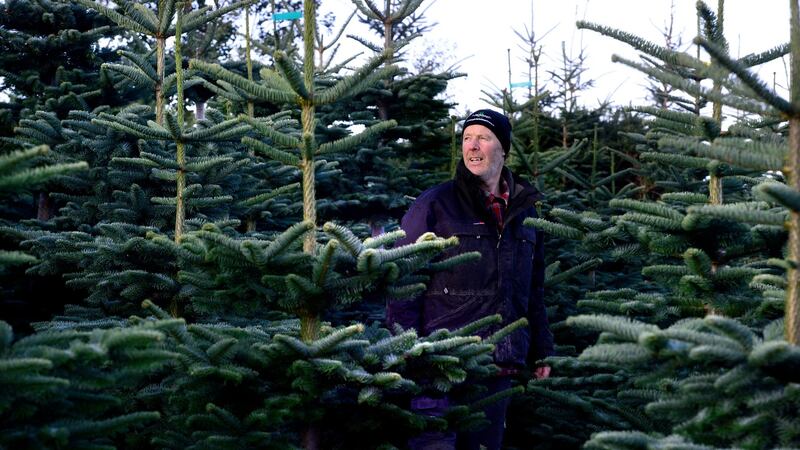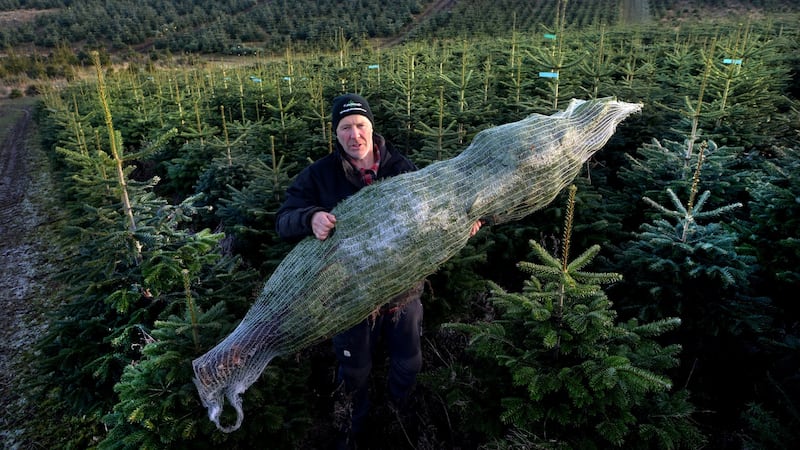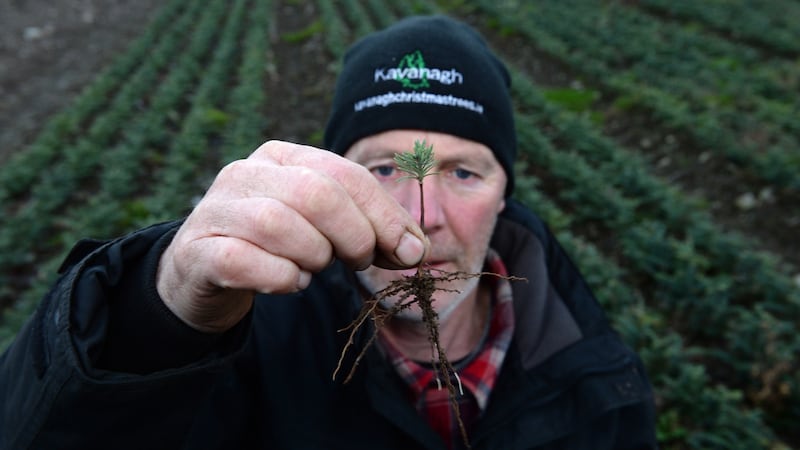A Christmas tree farm is a magical sight at this time of year. And Kavanagh’s Christmas Tree farm above the Co Wicklow village of Newtownmountkennedy has a particularly impressive variety of Christmas trees at all stages of growth.
Here, you can see everything from tiny one-year-old trees in the outdoor nursery, to 15-18 foot tall trees destined for corporate foyers and state buildings.
On a four-wheel drive tour of the sloping 48-hectare site, Christy Kavanagh points out the rows of the popular dark noble fir interspersed with Nordmann Fir – a lighter green conifer which has recently become the most popular Christmas tree in Ireland.
Kavanagh took over the growing of Christmas trees from his now deceased father, Tommy Kavanagh, who first planted Christmas trees here over 50 years ago.
“The Forest Service imported and grew Christmas trees in the 1940s and 1950s and my father started growing them from seed then. We still grow some from seed,” explains Kavanagh.

As he drives from field to field of Christmas trees aged between five to 12 years, he shows The Irish Times newer species of Korean Fir and Lasio Carpa Fir – which he predicts will become popular in the future.
“The first Christmas trees brought indoors in Ireland were Norway Spruce, then people turned to Lodgepole pine. Now it is Noble and Nordmann Fir but we’re always trying to stay ahead of the posse which is why we’re planting Korean Fir and Lasio Carpa Fir.”
The Korean Fir is a much fuller tree than either the Noble or Nordmann Fir and has little white buds on the end of its branches, which add a glistening look to the tree. The Lasio Carpa Fir has a bluish tinge to its needles (comparable to a blue Spruce) which gives it a more distinctive look.
Kavanagh is proud of his Christmas tree farm.
“I walk it every day and every night. It’s like a therapy for me. It’s beautiful up here – on a good day, you can see as far as Wales to the east and the Sally Gap to the west,” he says.
High fences keep out deer and buried netting wire keeps rabbits and hares at bay.

“Our biggest job is to keep the trees clean and dry when we’re cutting them down,” explains Kavanagh.
Most of the trees from this Christmas Tree farm are destined for superstores across Ireland and export to the UK, Germany and Belgium. The dry shaly soil in counties Wicklow, Wexford and Carlow is particularly suitable for growing Christmas trees.
Became widespread
The use of evergreen trees to celebrate the winter season predates the birth of Christ. But the tradition of decorating Christmas trees started in 16th-century Germany. Martin Luther is credited with illuminating one with candles to celebrate God’s glory reflected in stars. The practice of bringing trees indoors in this part of the world dates back to Victorian times when the German-born husband of Queen Victoria, Prince Albert, brought the tradition to England.
In Ireland, it wasn’t until the 1940s that bringing evergreen trees indoors became widespread. At that time, the rough top off-cut of Norway Spruce thinnings was the usual source of Christmas trees. The more widespread use of central heating prompted a move towards fir trees, which are less likely to shed their needles.
More recently, the environmental impact of cutting down and transporting trees to be put up in people’s homes at Christmas time has been questioned. Researchers have found that coniferous trees take more carbon out of the atmosphere than deciduous trees, so the key is for Christmas tree growers to replant a tree for every one they cut down – which most do.

However, some researchers have gone one step further by looking at the life cycle analysis of a real Christmas tree compared with an artificial tree. To really work out which is less harmful to the environment, you’d have to take into consideration environmental costs of transporting the Christmas tree from the farm to your home and whether the tree is mulched at the end of its life (so the carbon is returned to the soil) or put in landfill (where it will generate methane, a more potent greenhouse gas than carbon dioxide).
One Canadian study compared the environmental impact of real Christmas trees to artificial trees. And while, artificial trees scored poorly because they are made of plastics and metals, are transported around the world for sale and are rarely recycled, keeping one for several years reduces its environmental impact.
“The Canadian study found that if you kept your artificial tree for 20 years, it would be equal to using a natural tree every year,” says Dr Fionnuala Murphy from the school of Biosystems and Food Engineering at University College Dublin.
However, the study also points out that the carbon impact of your choice of Christmas tree are negligible compared to many other activities. In fact, you could offset the carbon emissions from either option by cycling to work for a couple of weeks a year.
Panel: Choosing and looking after your Christmas tree
Irish-grown Christmas trees are widely available for purchase in pop-up Christmas tree markets and Christmas fairs, plant nurseries and super stores throughout Ireland.
Some members of the Irish Christmas Tree Growers Association (christmastreesireland.com) also sell Christmas trees directly to the public from their Christmas Tree Farms.
These include: Slade Valley Christmas Tree Farm, Brittas, Co Dublin (087-9250064); Wheelock Christmas Trees, Moneyhore, Co Wexford (086-2629034); the Wicklow Way Christmas Tree Farm, Roundwood, Co Wicklow (086-2582684); Rath Con Farm, Grangecon, Co Wicklow (086-8292309); and Kelleher’s Christmas Tree Farm, Brannockstown, Co Kildare (045-483822/087 2453795).
In all cases, members of the public can choose their own tree from the field and have it cut on site.
When you bring your Christmas tree home, it’s best to cut a few centimetres off the bottom of the tree’s stem and stand it in a bucket of water. Shake off any loose leaves before bringing it indoors. Once indoors, Christmas trees are best kept on stands in containers of water topped up with about half a litre of water daily. It’s also a good idea to place the Christmas tree in the coolest part of your room, away from doorways, heaters, radiators and open fires. Christmas tree lights should be property wired and unplugged at night time. Take your tree to the nearest local authority mulching site at the end of the festivities.











